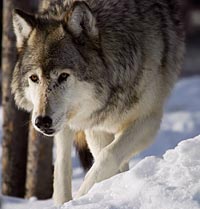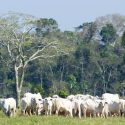History of Wisconsin’s wolf policy filled with compromise, meddling
To some, last month’s federal decision that put the gray wolf back on the endangered species list in the Great Lakes region was an unmitigated triumph. Siding with the Humane Society of the United States and other groups, the court ruling placed the wolf once again under federal protection after it was removed from the list last March.

But in doing so, the decision also took away critical tools from the states, such as the ability to kill wolves that have attacked livestock. And, in that sense, it’s not a victory but a blow to Wisconsin’s hard-won compromise on how best to manage the iconic animals, says UW–Madison environmental studies professor Adrian Treves.
“The irony in the current situation is that the state has found a constructive middle ground (on wolves),” says Treves, who has just published an analysis of 30 years of Wisconsin wolf policy. “But it’s consistently having that middle ground undermined by the federal government and through lawsuits by outside groups, usually wolf preservationist groups.”
Writing in the current issue of the journal Human Dimensions of Wildlife, Treves argues that the history of wolf recovery in Wisconsin is one of “interest groups vying for control” of wolf policy and the Wisconsin Department of Natural Resources (DNR) balancing those interests. Over the past 26 years, for example, the agency has promoted coexistence with wolves by compensating people for lost livestock and pets with funds paid for by wildlife enthusiasts.
“This clash of values can easily be portrayed as irreconcilable. However, our research suggests that there’s a lot more common ground. People don’t look at the wolf universally as pest, game, or icon. They’re more flexible.”
Adrian Treves, environmental studies professor
In recent years, the DNR also began exploring the idea of a hunt to control Wisconsin’s wolf population, numbered now at more than 550 animals. Hunters have lobbied strongly for this management strategy, but Treves’ public opinion research also shows that a hunt carefully designed to reduce attacks on domestic animals might also be broadly acceptable.
There is also a history, however, of outside groups interfering in this delicate balancing act by litigating at the federal level, Treves says. Due to lawsuits, for example, the DNR has repeatedly lost federal permits allowing it to kill known livestock predators, even though this policy enjoys support from diverse interest groups around the state.
This points to another effect of these high-profile disputes: They often make the gulf between people who hold a utilitarian view of wildlife and those who take a preservationist position seem wider than it actually is, says Treves.
“This clash of values can easily be portrayed as irreconcilable,” he says. “However, our research suggests that there’s a lot more common ground. People don’t look at the wolf universally as pest, game, or icon. They’re more flexible.”
Based on his analysis, Treves now predicts the U.S. Fish and Wildlife Service will contest last month’s ruling, launching yet another round in the battle over Great Lakes wolves. So, how will the cycle be stopped? For one, Treves suggests residents voice their opposition to outside groups who try to shape state policy through the courts, rather than through consensus-building and public participation.
He also urges the DNR and the public not to give up on the participatory process itself, but to stay engaged in discussions that weigh the scientific evidence for and against different management strategies — and consider the values of state residents.
“There is a middle road — it’s out there,” he says. “The DNR found it (in the past) as far as wolves are concerned in the state. And I think they can find it again.”



